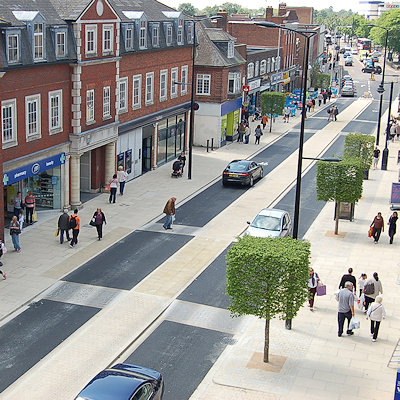
Like us on Facebook
PLACE NAMES


 
|
|
Hornchurch
|

| |
Hornchurch is an Anglicised version of the Latin Monasterium Cornutum, a term that was also applied to the mother Abbey in Savoy. The earliest recorded use here was in 1222, meaning "church with horn-like gables" and it was recorded as "Hornechurch" in 1233. The horned bull's head mounted on the eastern end of St Andrew's Church, near the town centre dates from much later, around the 18th century.
In the Anglian Ice Age, 450,000 years ago, the ice sheet reached The Dell, just south of St Andrew's Church in Hornchurch, the furthest south any ice sheet reached in Britain. Hornchurch Cutting is a Site of Special Scientific Interest just north of St Andrews Park which exhibits the geology.
Stone Age tools, Bronze age and Iron age artefacts have been discovered in Hornchurch, indicating a lengthy occupation in pre-history. Roman remains, sufficient to indicate a settlement have also been found in South Hornchurch. Hornchurch originates from around the 12th century when Henry II gave 1,500 acres (610 ha) to the hospice of St Nicholas and St Bernard, Mountjoux, in Savoy as a gift. A prosperous Hornchurch Priory was established, near the parish church, but the monks were forced out during the 14th century when a new law banned foreign land ownership. The lands were then given to Lord Chancellor William of Wykeham who made major renovations to the church. He subsequently gave Hornchurch to endow New College, Oxford, which still owns all the local church lands and buildings. Due to this, Saint Andrew's Church was not adopted into the Diocese of Chelmsford until agreement was reached in the 1930s. The parish remains staffed by a vicar temporal and his curates.
Due to the status of Hornchurch as a "commuter town", it has a large population that commute to Central London each day to work. As a result, the town is above the UK average for GDP per capita, and has a large number of people with professional degrees living in the area.
The Towers Cinema on Hornchurch High Street opened in 1936. The Kemp & Tasker building, which was converted into a bingo hall in 1973, is noted for its Art Deco architecture. As of 2016 it is scheduled for demolition to make way for a supermarket.
|
 Feel free to Email me any additions or corrections Feel free to Email me any additions or corrections
LINKS AVAILABLE TO YOUR SITE
| |





